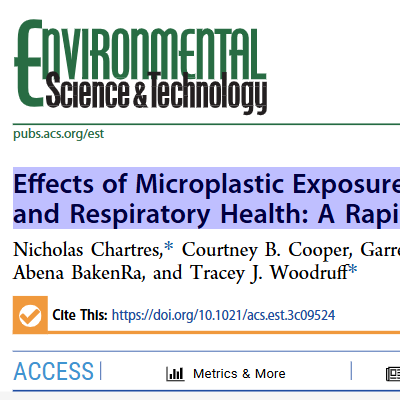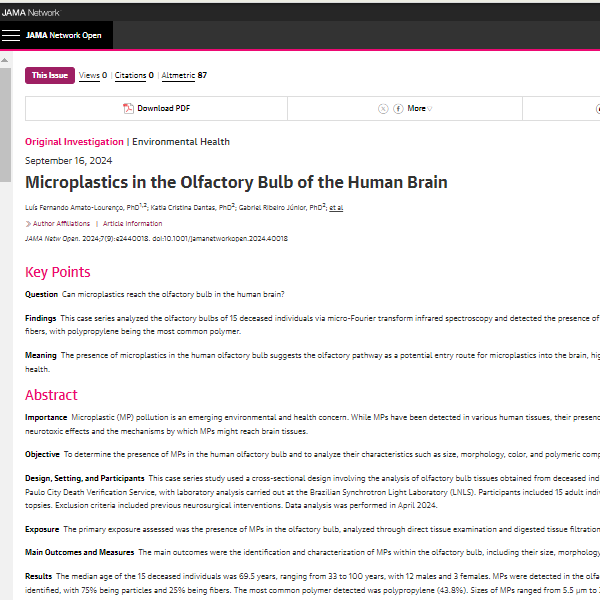
Comparative assessment of microplastic ingestion among deep sea decapods: Distribution analysis in Sardinian and Catalan waters
This study presents, for the first time, a comprehensive evaluation of microplastic ingestion levels in four ecologically and commercially significant crustaceans, spanning two distinct regions in the Mediterranean Sea. By addressing this critical knowledge gap, a consistent methodology was used, enhancing data comparability and providing novel insights into regional and species-specific patterns of microplastic exposure.

More Recycling Lies: What the Plastics Industry Isn't Telling You About "Chemical Recycling"
For decades, the plastic industry has promised that recycling would solve the problem of plastic waste, yet the plastic crisis continues to grow. The dismal U.S. plastic recycling rate continues to hover around 5 percent. Globally, plastic use is projected to almost triple by 2060, relative to a 2019 baseline.
NRDC’s new issue brief “More Recycling Lies” confirms and expands on our previous findings: So-called “chemical recycling” is mostly plastic incineration.

Microplastics in the bloodstream can induce cerebral thrombosis by causing cell obstruction and lead to neurobehavioral abnormalities
We show that circulating MPs are phagocytosed and lead these cells to obstruction in the capillaries of the brain cortex. These blockages as thrombus formation cause reduced blood flow and neurological abnormalities in mice. Our data reveal a mechanism by which MPs disrupt tissue function indirectly through regulation of cell obstruction and interference with local blood circulation, rather than direct tissue penetration.

Effects of Microplastic Exposure on Human Digestive, Reproductive, and Respiratory Health: A Rapid Systematic Review
We concluded that exposure to microplastics is “unclassifiable” for birth outcomes and gestational age in humans on the basis of the “low” and “very low” quality of the evidence. We concluded that microplastics are “suspected” to harm human reproductive, digestive, and respiratory health, with a suggested link to colon and lung cancer. Future research on microplastics should investigate additional health outcomes impacted by microplastic exposure and identify strategies to reduce exposure.

Co-exposure of ferruginous components of subway particles with lipopolysaccharide impairs vascular function: A comparative study with ambient particulate matter
The study shows plastic exposure as a significant CVD risk factor regardless of duration. It leads to changes in myocardial tissue, gut microbiota, and metabolites, all closely tied to CVD.

Buildings’ Hidden Plastic Problem
In this brief, we present highlights from the significant body of science indicating that plastic building materials are contributing to serious health and environmental harms over their life cycle, from fossil fuel extraction to production, use, and disposal. These impacts fall disproportionately on susceptible and marginalized people, including women, children, Indigenous people, low-income communities, and people of color. We share examples of solutions and offer recommendations to strengthen policies that will reduce plastic use in the built environment and associated life cycle harms.

Presence of microplastics in human stomachs
This study presents the first definitive confirmation of microplastic presence in the human stomach, based on samples from 26 cadavers. 97 microplastic particles were extracted from stomach contents, across all 26 individuals, revealing a universal prevalence of microplastics in the cadavers.

Association of mixed exposure to microplastics with sperm dysfunction: a multi-site study in China
Our findings highlight the potential reproductive health risks posed by microplastic contamination, particularly PTFE, a non-stick pan coating material, and raise concerns about the potential of urine testing as an indicator of male reproductive microplastic exposure. Future research is warranted to further elucidate the mechanisms underlying the adverse effects of microplastics on male fertility and cross-generational effects.

Microplastics in the Olfactory Bulb of the Human Brain
This case series provides evidence of MPs found in the human olfactory bulb, suggesting a potential pathway for the translocation of MPs to the brain. The findings underscore the need for further research on the health implications of MP exposure, particularly concerning neurotoxicity and the potential for MPs to bypass the blood-brain barrier.

Discovery and analysis of microplastics in human bone marrow
Pyrolysis-gas chromatography-mass spectrometry (Py-GC/MS) is an emerging thermal analysis technique that reliable qualified and quantified data for MPs risk assessment of human health [15], [26]. Laser direct infrared spectroscopy (LD-IR) has been widely used to characterize of MPs, including their type, size, and morphology [12]. This study utilized Py-GC/MS, LD-IR, and scanning electron microscopy (SEM) to analyze and identify the accumulation of MPs in the bone marrow. The results provide crucial data for evaluating the risks of MPs on human haematopoietic injury, and support further studies with larger sample sizes and more detailed designs to explore the health implications of MPs in human bone marrow.

Chemical Recycling: A False Promise for the Ohio River Valley
Ohio River Valley Institute’s July 2024 report explores the many reasons why chemical recycling is a false promise for the region, from hazardous chemicals, to greenhouse gas emissions, the habitat and ecosystem degradation, to the technology’s expense and general lack of success, and more.

Microplastic presence in dog and human testis and its potential association with sperm count and weights of testis and epididymis
Our study revealed the presence of microplastics in all canine and human testes, with significant inter-individual variability. Mean total microplastic levels were 122.63 µg/g in dogs and 328.44 µg/g in humans. Both humans and canines exhibit relatively similar proportions of the major polymer types, with PE being dominant. Furthermore, a negative correlation between specific polymers such as PVC and PET and the normalized weight of the testis was observed. These findings highlight the pervasive presence of microplastics in the male reproductive system in both canine and human testes, with potential consequences on male fertility.

Bioaccumulation of Microplastics in Decedent Human Brains Assessed by Pyrolysis Gas Chromatography-Mass Spectrometry
Rising global concentrations of environmental micro- and nanoplastics (MNPs) drive concerns for human exposure and health outcomes. Applying pyrolysis gas chromatography-mass spectrometry (Py-GC/MS) methods to isolate and quantify MNPs from human samples, we compared MNP accumulation in kidneys, livers, and brains.

State of the Science On Plastic Chemicals
Although there is a wealth of scientific information on plastic chemicals and polymers to inform policymakers, implementing this evidence is challenging because information is scattered and not easily accessible. The PlastChem report and database address this issue by comprehensively and consistently synthesizing the state of the science on plastic chemicals, including their hazard properties, and their presence in polymers. The state-of-the-science report provides the publicly available evidence to inform policy development that protects public health and the environment.

Microplastics and Nanoplastics in Atheromas and Cardiovascular Events
Plastic waste is a growing problem, and as plastics break down the pieces can be problematic. A new study in Science Advances suggests that tiny plastic particles may be the latest environmental contributor to Parkinson’s disease (PD)

Plastic Waste Contaminants Could Promote Parkinson’s
Plastic waste is a growing problem, and as plastics break down the pieces can be problematic. A new study in Science Advances suggests that tiny plastic particles may be the latest environmental contributor to Parkinson’s disease (PD)

Identification and analysis of microplastics in human lower limb joints
Our findings demonstrate the presence of MPs in human joints and suggest that further studies are needed to explore the intricate associations between MPs and anatomical location, clinical diagnosis, and local cellular responses.

PureCycle’s (PCT) Failure To Launch
After a months long investigation, backed by interviews, regulatory filings, and visual evidence reveals that the facility has yet to start commercial scale production four months later. We have spoken with Ohio regulators that have contradicted company claims, and former employees that have exposed numerous issues. We believe PureCycle has mislead investors about the launch of its facility, or at the very least, will not come anywhere close to meeting production targets.

Hazardous Chemicals in Recycled and Reusable Plastic Food Packaging
All types of water pipes, not only lead, can release chemicals into drinking water. Plastic pipes, which are constructed from potentially dozens of different chemicals, release more contaminants into drinking water than unlined metal pipes, which are built of few materials. Communities need to understand the potential health risks associated with different water pipe materials so that they do not end up with what’s known as a “regrettable substitution,” or a situation in which a selected alternative turns out to be just as bad, if not worse, as the original option.

The Perils of PVC Plastic Pipes
All types of water pipes, not only lead, can release chemicals into drinking water. Plastic pipes, which are constructed from potentially dozens of different chemicals, release more contaminants into drinking water than unlined metal pipes, which are built of few materials. Communities need to understand the potential health risks associated with different water pipe materials so that they do not end up with what’s known as a “regrettable substitution,” or a situation in which a selected alternative turns out to be just as bad, if not worse, as the original option.

